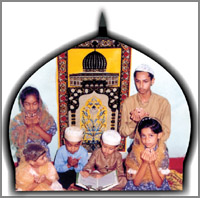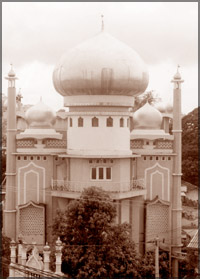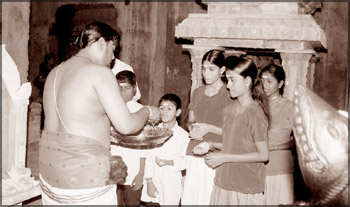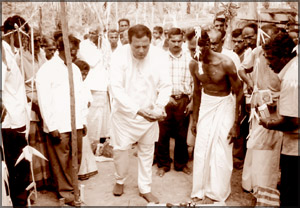|
Religious Page Islam:
Religious tolerance and Islam
M.B.M. Mahir
|

Islam |
tolerance: To recognise all the religions, their books and their
messengers is a basic principle of Islam. From time immemorial these
messages and messengers have guided the destiny of humanity.
Unity in diversity is the norm behind religious understanding. Hence
the approach to religious tolerance should begin from the intellect and
the individual on a general and generous knowledge of religions.
In Islam, religious tolerance is a basic quality of a true Muslim.
Islamic law applies different interpretation to Muslim society living
amongst Non-Muslim communities. In a Hetra Genious community where in
various groups and beliefs are prevalent religious tolerance becomes a
way of life.
In the annals of Islamic history we observe many interesting
references of Islamic tolerance towards other religions.
In the early period of Islam, when prophet Muhammed (P.B.O.H.)
confronted opposition to his mission he exercised tolerance and patience
towards his opponents and won over them. "The peace of Hudaibiya" a
treaty which he signed with the opposing Non Muslim Quaraish is an
exemplary situation. The prophet came with his followers to Mecca to
perform Haj. But he was stopped at a place called Hudaibiya by the
Quraish. Among opposition from his own friends the prophet agreed to go
back to Madina and return next year for Haj, avoiding bloodshed and
confrontation. The Holy Quaran refer to this incident and commends the
prophet as "We have bestowed great success to you" when you signed the
treaty of peace, Almighty Allah's grace was with you'.
In the life and mission of prophet Muhammed (P.B.O.H.) we come across
many incidents of religious tolerance.
When Anashabi (friend) who embrace Islam, failed to visit his mother,
the prophet advised him to visit her and care for her even though she
has not embrace Islam. care for her even though she
has not embrace Islam.
The prophet was very kind to the Christians and Jews and always
entertained them for discussion. Even in the battlefield, he treated the
prisoners of war respectfully. Among the prisoners if there were
educated ones, he made them to teach as a price for freedom. Similarly,
those who excel in carpentry, armoury, physical ability and the like
were made to use their talents on the less fortunate, and release them
with honour. He was indeed a personification of religious tolerance.
It is interesting to observe that during the caliphate of Hazrath
Umar (Rali) many incidents of religious amity are reported. Hazrath Umar
has availed the opportunity of praying in Christian Protestant Churches
during his visit if and when mosques are not available. Once, Amr Iba al
Mas was governor under Hazrath Umar, a vagabond has damaged the statue
of Jesus Christ purposely to create religious disturbances. This action
hurt not only the Christians but also the Muslims.
The culprit was found and punished. Both the Muslims and Christians
together restored the prestige and reinstalled the statue in its
original form. This demonstrates the impact of religious tolerance in
Islam. Lately when India was ruled by Moghol Kings, they have always
cared for the Hindu religion in particular and all other in general.
King Akbar, King Arber Bathusha and others are shining examples of
religious tolerance, Akbar introduced a system called "Deene Ilahi" to
bring co operation and collaboration among Hindus and Muslims.
Religious beliefs should not encourage violence, hatred and enmity
among its followers, as unity, love and friendliness will be destroyed.
In our days it is encouraging to note the participation of all religious
leaders in state functions and collectively contributing for peace and
harmony. This gesture will develop religious tolerance.
In our days, we have known of incidents where the Buddhist clergy
have been generous enough to accommodate. The Faisal Jamaath, the
walking group of the Thabligh movement, who travel by foot and stop at
over night in mosques. At some places they have been accommodated in
Buddhist Viharas to spend the night. This action of the Buddhist clergy
is a great example of tolerance and amity.
In this age of computer, internet, web and the like it is very much
essential for all religious faiths and beliefs to execute unified action
and pave the way for religious tolerance. Islam and Muslims can set an
unique example as the great scholar, Dr. Saeed Ramadan observes. "At a
time the very existence of religion is at stake any effort to promote
the cause of moral values is the timely contribution to meet the combat
and challenges of our age. Being Muslims, it is only honest to make a
start."
Islam - historic and definite
This article is based on the book titled, 'An Approach to the Study
of the Quran' by Sir Nizamat Jung.
ANALYSIS: Islam has two distant advantages over the other great
religions of the world - that of having been born in the full light of
history - and that of having been given to the world in the form of an
unalterable document. Hardly any other religion can claim the same
definiteness either in respect of its birth or of its content. And this
is the main reason why there is no mystery about Islam and why it has
been so little liable to the illusive process of traditional
mystification.
 Almost all historians have analysed the chronological and other
relevant facts about Prophet Muhammed (Sal) and his family. Similarly,
what Quran revealed to Prophet Muhammad (Sal) has ben analysed by both
Muslim and non-Muslim linguists and researchers and has been found to be
an unalterable book of guidance to mankind. Almost all historians have analysed the chronological and other
relevant facts about Prophet Muhammed (Sal) and his family. Similarly,
what Quran revealed to Prophet Muhammad (Sal) has ben analysed by both
Muslim and non-Muslim linguists and researchers and has been found to be
an unalterable book of guidance to mankind.
Supervised by Providence, the Quran was given to the world by
revealing in a very definite rational sense to a very definite human
being who was neither a myth nor a shadowy Godman. It was sent right
into the midst of two great empires bordering upon the land of its
birth; it came into conflict with them; it overcame both and was
completely absorbed by one of them.
It subjugated ancient kingdoms not so much by its arms as by the
forceful vitality of its new culture and civilization. There is no
mysterious haze surrounding it; it stands out before our eyes a clearly
defined historic fact. And there is no mystery in its tenets because
they rest upon three simple fundamental beliefs supported by reason: (1)
The undoubtable supremacy of one omnipotent creator and controller of
all things; (2) His communication of vital truths to man through a
chosen messenger in the form of Revelation; (3) An intelligible message
rationally explained for the spiritual and moral guidance of man in his
present life.
Here is a conception of religion too simple to admit of sacerdotal
mystification. It brings faith within every man's reach and makes it
acceptable through reason.
1. There is but one God (Allah) Omnipotent, Just and Merciful who can
say this without becoming an atheist or polytheist?
2. He appoints messengers and guides for directing man on the
straight path. Who can question the truth of this without setting aside
all the Prophets and teachers and leaders known to all the religions?
3. He sends an intelligible message for the moral and spiritual
guidance of man. Who can contest this without dissociating morality from
religion and thus making the latter useless.
To anyone who recognises the truth of all this, there can be no doubt
as to the strength of the claim put forward for Islam on these general
grounds. But, it is conceivable that if such a person happened to be a
non-Muslim, he might be inclined to question whether the great Prophet
of Islam was a real Prophet missioned by God (Allah). The answer to this
would depend upon one's notion as to what a real Prophet is, with what
qualities he is endowed, in what manner he appears and conducts his
mission, what kind of message he conveys to mankind and whence his
impulse to action is derived.
Compiled by M. Y. M. Meeadh
Hinduism:
Nallur Kanthaswamy festival attracts thousands of devotees
|

Hinduism |
festival: The annual festival of Nallur Kanthaswamy festival in
Jaffna, Sri Lanka commenced on August 18, with Kodi Etram - the ceremony
of flag hoisting to mark the beginning of the festival in the temple.
The festival commenced yesterday at 10 AM. According to tradition,
Nallur Kanthaswamy Temple is said to be one of the few temples in the
Peninsula that all the festivals, rites and observances as found in the
Hindu traditions are practised and reflected with regularity, splendor
and pageantry.
The temple festival is being held for 25 days. Unlike earlier annual
festivals, according to the temple authorities, this year the festival
is to be held with subdued version of the pageant and pageantry.
The day pooja (adoration of deities with rituals) is to be held with
the temple deity taken in a procession within the inner court of the
temple. The evening pooja during the festival days will be held with the
deity taken in procession at 4.45 pm. Temple authorities revealed that
the day's pooja will be over by 5.30 in the evening for that day. On
August 16, the temple flag was brought to the temple in a procession
from the Theradi Murugan matt located at the Sattanathar Street. the inner court of the
temple. The evening pooja during the festival days will be held with the
deity taken in procession at 4.45 pm. Temple authorities revealed that
the day's pooja will be over by 5.30 in the evening for that day. On
August 16, the temple flag was brought to the temple in a procession
from the Theradi Murugan matt located at the Sattanathar Street.
The annual festival of the famous Nallur Kandasamy Temple in the
Jaffna peninsula is expected to draw tens of thousands of pilgrims from
across Sri Lanka and also a few hundreds of Tamil expatriates from
Western countries.
Nallur Kanthaswamy Temple is one of the most important temples in the
Jaffna peninsula. The annual festival used to commence on the sixth day
of the Amavaci- New moon in the month of Aadi (July - August) and last
for 25 days.
It is said to be one of the impressive temples dedicated to Lord
Murugan.The annual festival of the famous Nallur Kandasamy Temple in the
Jaffna.
|

A special pooja and religious programme organised by the pupils
and the teachers of Ratmalana Orphans School affiliated to the
All Ceylon Hindu Congress to commemorate the 5th death
anniversary of its Patron late Dr. K. Velauthapillai were held
at Karpaga Vinayagar Kovil, Ratmalana recently. Here students at
the pooja with the Kovil chief priest.
Picture by: A. Maduraveeran |
Many devotees carry kavadi, an act of paying penance. A kavadi is a
decorated arch with two milk pots to be offered in the worship. Many
carriers also pierce their body with small silver spears or hooks.
Rolling around the temple on the hot sand is also a common practice.
Normally fifty temple priests conduct different activities on
|

A gopuram built inside the Munesweram temple. Picture by
Christie Fernando,
Chilaw special corr. |
each of
the 25 days of the festival, beginning with the flag raising through a
series of very elaborate ther - chariot processions to the final
theertham - "water cutting" ceremony to immerse the deities and mark the
festival's end.
Historians say that the history of the Nallur temple is closely
intertwined with the history of Jaffna. Prof. Gunarasa of Jaffna
University in his book on the Temple says that the Temple was originally
constructed in a place called Kurukal Valavu in A.D 948. The temple was
destroyed in AD 1450 during the invasion of the Sinhalese King
Shenpakaperumal (Sapumal Kumaraya). Sapumal Kumaraya defeated King Arya
Chakkaravarthi, destroyed his palace and the original Nallur temple. But
upon becoming Buvaneka Bahu the 6th, he sought to make amends by
building a new temple in 1467 at a nearby location, says Shanmugapriya
in Nallur Kanthaswamy: A Spiritual Experience.
S.Pathmanathan in his Hindu Temples of Sri Lanka states the temple
established by Buvaneka Bahu continued
|

CONSTRUCTION OF NAVAGRAHA TEMPLE:The Chief Organiser of Up
Country People’s Front for Uva Province and Member of Uva
Provincial Council A. Aravindh Kumar lays the foundation stone
for a Navagraha Temple at Uva Ben Head Estate, Welimada. V.
Rasaligam member of Welimada Pradesiya Saba and M. Muthusamy,
Area Organiser for Up Country People’s Front and S. Jothivel
Industrial Relations Officer of the Up Country Workers’ Front
are also in the picture. |
to flourish even after he had
lost authority over Yappanam and the Tamil Kings who were restored to
power around 1467 extended royal patronage until they were displaced
from power around 1620 by the Portuguese. Philip de Oliveyra who took
control of Yalppanam in 1619 ordered the large Nallur temple razed down
in 1621.
Thereafter according to C.S. Navaratnam in 'A Short History of
Hinduism in Ceylon, wrote, for nearly 170 years there were no temples
for worship for the Hindus in that locality. When the Dutch in their
latter period became more liberal, some pious people applied for
permission to build a temple and permission was granted in 1773. The
temple was again reconstructed in 1774 during the time of Dutch rule by
Irakunatha Mappanar Mudaliyar in the piece of land that belonged to the
old Kanthaswamy Temple.
Today Nallur Kanthaswamy Temple is the best administered temple in
the Island and in its popularity it is only second to Kataragama.
- Asian Tribune |

